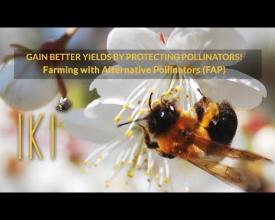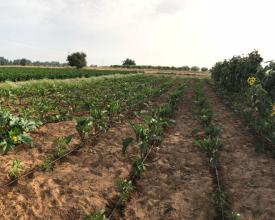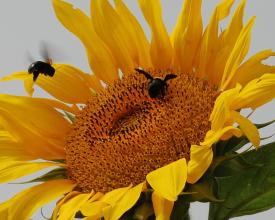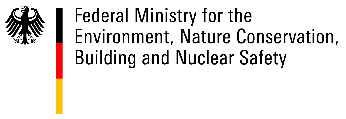
Farming with Alternative Pollinators (FAP)
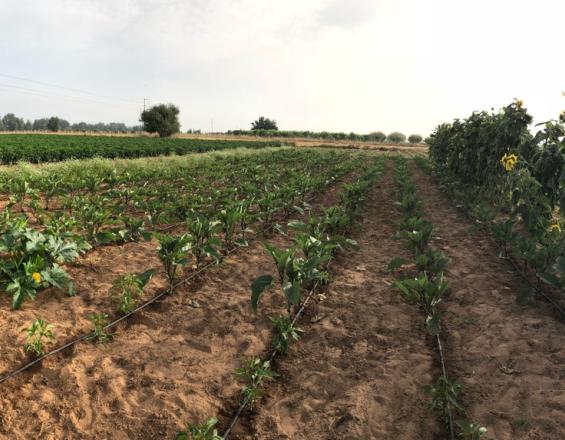
Farming with Alternative Pollinators (FAP) is a new low cost and economically self-sustaining approach to protect pollinators (Christmann and Aw-Hassan 2012; Christmann et al. 2017; Christmann 2019a, b). FAP increases the net income per surface substantially and thus obviates rewards. FAP compares FAP fields (75% of the area for the main crop, 25% of the field for habitat enhancement including different marketable plants to attract a higher diversity of pollinators, provide shelter against wind, nesting and water support out of local materials), with control fields (100% for the main crop) concerning insect diversity and abundance (pollinators, predators and pests) and total net income. The approach is replicable across continents and affordable also for Low Income Countries. FAP focuses on capacity building, a performance and productivity related incentive for farmers and a cross-sector policy mix. It generates many cross-cutting benefits (Christmann 2019c).
Contexte
Défis à relever
Pollinator diversity in Low and Middle Income Countries is hardly known, research is focused on High Income Countries to a high extent, so there is no baseline to measure decline.
Same as in Europe, pollinator research in the South is mainly conducted by biology departments of universities, but not by applied agricultural research organizations.
Unfortunately, there is a tremendous lack of research on pollinators from socio-economic and policy research, but such data would be valuable for policy dialogues.
Capacity of farmers is low. Insects are often regarded as potential pests.
Low and Middle Income Countries cannot pay rewards as e.g. the European Union, so the approach for pollinator protection must be self-sustaining.
Emplacement
Traiter
Résumé du processus
Researchers cannot develop planting instructions on all main crops of a region, just on the most important crops. However, if farmers realized the potential of higher income per surface and have figures for some crops, they start to experiment themselves. At that time, the Seeding-Flowering Calendars might be very effective.
Also see the graphics below:
Blocs de construction
Assess the total net income from FAP and Control Fields
Income is the best incentive for farmers.
Facteurs favorables
The methodology is in detail described in Christmann et al. 2017. On farm trials using the same inputs in all fields (inputs according to usual practice of farmers, so other farmers can gain the same net income).
Select marketable plants together with farmers. Which ones are useful for them? Do they flower during the flowering time of the main crop or before/after - to sustain pollinators in the field over a longer period. Check before seeding: not all useful crops recommended by farmers attract pollinators.
Leçon apprise
It is important that at least some plants in the habitat zone provide really good income. Farmers select those habitat enhancement plants, which they regard as most useful. Their criteria might differ from the researcher's criteria, so better seed a wide range of habitat enhancement plants. Include oil seeds and spices, they are very attractive. Check, if they don’t attract pests at this specific seeding time. Check, if they can grow (water demand) under the same conditions as the main crop.
Ressources
Mainstream field work by policies
Knowledge is the basis of protection. Prepare visual material to send to smartphones. Use radio, social and mass media. Check national curricula for primary and secondary schools, if they include lessons on pollinators and pollination. If not, discuss with the curricula unit of Ministry for Education. Start a dialogue with Ministry for Agriculture to recommend FAP as farming practice, to develop a more ambitious national regulation for agricultural chemicals or a ban of imported managed bumblebees (which can transfer diseases and pests to indigenous species). Clarify with Ministry of Interior, if they can better protect hedgerows and old wood in agricultural areas. Discuss with national universities and Ministry for the Environment, if they can monitor pollinator diversity and include the results in their national reports to CBD, or what kind of capacity building they might need in advance. Clarify with Ministries for Tourism and Urban Planning, if they can conduct a yearly competition for the best performing rural and urban area concerning pollinator protection and promote the winners for ecotourism. Conduct a national pollinator round table with various ministries. Join Promote Pollinators (https://promotepollinators.org/). Read more in: Christmann 2019b
Facteurs favorables
Some ex-ante surveys e.g. on knowledge concerning pollinators and pollination among different stakeholder groups are quite helpful. Also, the value of pollination for crop pollination is not only assessed globally, but also for various countries. These figures are quite convincing that the service of pollinators should be sustained. If you convince the national government to join Promote Pollinators (https://promotepollinators.org/) they join a group of likeminded countries and get part of exchange of respective experience.
Leçon apprise
Knowledge is the basis for protection.
Impacts
In the most common approach for pollinator protection, wildflower strips (weeds in the language of farmers) farmers do not gain income from this part of the field (except he is paid for the seeding service), but face spread of weeds. FAP uses instead marketable habitat enhancement plants like oilseeds, spices, food crops, medicinal plants etc, so farmers have income also from the habitat enhancement zone. In general, the higher productivity and quality of the main crops is the main factor for higher income, but if the main crop is heavily attacked by pests or diseases, the habitat enhancement zone buffers against income loss, because these plants are usually not affected. Also, pest abundance is much reduced. The farmer earns significantly more per surface, for some crops and ecosystems by 30%, 50% or much more (Christmann et al. 2017; results from 3 more FAP projects in Morocco are under development). The film documentary “Gain better yields by protecting pollinators” shows fields, farmers, important pollinators and also graphs on income increase (find the link below). FAP has positive impacts on health (less pesticides in food), food security, and most of all: FAP protects biodiversity in general: pollinators are crucial for biodiversity protection in general, as their service is basic for 87% of flowering plants, and thus for fauna and habitats as well.
Bénéficiaires
Farmers, consumers, rural development, pollinators, all plants, animals, habitats, ecosystem services relying on pollination service.
We trained more than 200 farmers and more than 300 professional trainers. NARS in 10 countries received trainings.
Objectifs de développement durable
Histoire
Laarroussi Touil protects wild bees and flies and thus earns more
In winter 2016/17, for the first time Laarroussi Touil took part in a project that aims to increase income faba bean production by attracting often overlooked unpaid field workers to the plot: pollinators such as wild bees, flies and wasps, but also natural enemies. The approach is called "Farming with Alternative Pollinators (FAP)" and was developed by a CIM expert in Uzbekistan 2009-2012. High pollinator diversity induces these insects to move more often from one flower to the other. This increases farmers’ yields. High diversity of wild pollinators also makes his production more climate resilient, because honeybees need good weather – and this cannot be taken for granted in the course of climate change.
The young farmer used about 75% of his field for faba bean and in 25% of the field, in the border around, he seeded canola, arugula, lupinus, chia and alfalfa. He saw that the variety of insects was much higher and the number of pests less than before. The harvest was much better, more flowers developed pods, the pods had more and bigger seeds than usual. Hanan Touil used the additional plants of the marginal strips in the kitchen and for the sheep. Laaroussi Touil was satisfied and became curious.
For some years now, the tomato leaf miner moth has been giving him a hard time - nearly all tomato growers in Morocco suffer from this larvae damaging the plant. Above all, the black excrement of the larvae in the tomatoes reduces the income per kilogram from 5 Dirham (good harvest) to 3. Chemicals can combat the larvae, but Laarroussi Touil uses a part of the harvest for his family and recognizes the risks related to chemicals: "It's hard and unhealthy work, expensive and the harvest is becoming unhealthier.” As he had noticed, that the faba bean field with the bordering plants had much lower pest abundance, he started his own project in spring 2017. He used the FAP approach for his tomato field. He sowed coriander, zucchini and sunflowers all around it to attract more pollinators and natural enemies to his field. He was very satisfied with the high quantity and quality of his tomato harvest. Meantime he started his own FAP trials with more main crops, e.g. green pepper and zucchini in 2018. He is in particular fond of coriander and sunflower as habitat enhancement crops.
